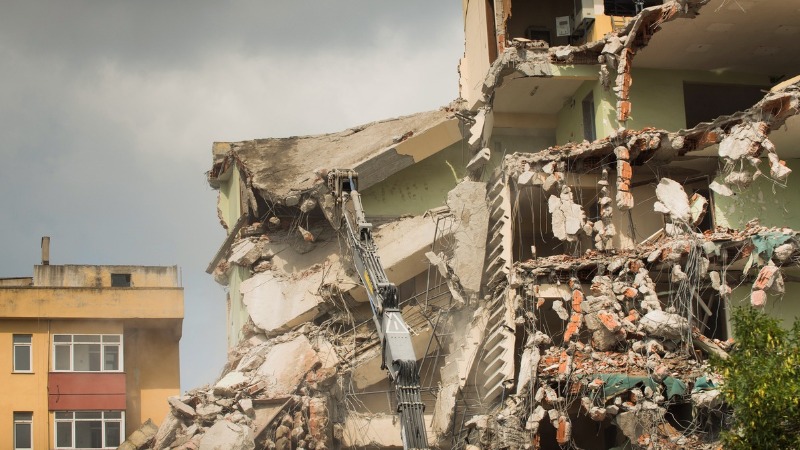Sacrificial device for buildings
In October 2017, engineers at Scotland's Heriot-Watt University released details of a ‘sacrificial device’ for buildings they have designed that will absorb the impact of earthquakes or blasts, preventing collapse and reducing the damage and residual drifts that can render buildings uninhabitable.
Current European ‘earthquake-proof’ buildings were designed to prevent collapse in the event of a strong earthquake. However, they do not prevent extensive damage that is difficult to repair, or residual drifts. If buildings experience one or both of these factors, the cost of repairs can become prohibitive, and demolition may be the only viable option.
Dr George Vasdravellis, assistant professor in structural engineering at Heriot-Watt University in Edinburgh, has used experimental testing and computer simulations to prove that his new system minimises the damage caused to buildings up to 10 storeys high in an area of high seismicity, with one in 475-year seismic events.
Now, he and his team are adapting the design for taller buildings to ensure that the novel, minimal-damage steel frame will address the disadvantages of conventional building design.
Dr Vasdravellis said:
"The non-repairable damage and residual deformations that conventionally-designed buildings experience after a seismic event represent a severe socio-economic loss. We need new methods of resilience to tackle this issue.
"We have developed an innovative steel frame that could achieve high seismic resilience, structural and non-structural damage control, and minimise residual deformations.
"The system makes use of 'sacrificial devices' made of stainless steel material. The devices are placed strategically in the structure, so that they are the only damaged components during earthquake loading.
"In the aftermath of a strong seismic event, they can be easily replaced with new ones, so that the building can return to its usual occupation very quickly.
"The inherent properties of stainless steel results in the significant reduction of the residual drifts after a strong earthquake.
"Through experimental testing and numerical simulations, we found that our system had negligible residual drifts under loading corresponding to the 'design earthquake', compared to conventional building designs, which experienced drifts that were four to five times larger."
The ability to retrofit the device and make it commercially viable for architects and construction firms is at the forefront of Dr Vasdravellis’s mind.
"In Greece and Italy we’ve watched new areas become seismic, where previously there had been little activity. We must also consider, unfortunately, the impact of explosions or other attacks on buildings that could impose extreme loading conditions.
"The sacrificial devices will mitigate progressive collapse due to explosions, or other extreme events, that result in the loss of one or more columns in the building. Therefore, we are further developing the system for multi-hazard mitigation.
"It is not enough to ‘earthquake-proof’ new buildings; we need simple, effective devices like this that can protect our existing built environment and heritage, minimising damage and costs in the event of a seismic event or blast."
Dr Vasdravellis was awarded £140,000 by the European Commission for the next stage of his research into earthquake engineering.
This article was originally published here on 25th Oct 2017 by CIAT.
--CIAT
[edit] Find out more
[edit] Related articles on Designing Buildings Wiki
Featured articles and news
RTPI leader to become new CIOB Chief Executive Officer
Dr Victoria Hills MRTPI, FICE to take over after Caroline Gumble’s departure.
Social and affordable housing, a long term plan for delivery
The “Delivering a Decade of Renewal for Social and Affordable Housing” strategy sets out future path.
A change to adoptive architecture
Effects of global weather warming on architectural detailing, material choice and human interaction.
The proposed publicly owned and backed subsidiary of Homes England, to facilitate new homes.
How big is the problem and what can we do to mitigate the effects?
Overheating guidance and tools for building designers
A number of cool guides to help with the heat.
The UK's Modern Industrial Strategy: A 10 year plan
Previous consultation criticism, current key elements and general support with some persisting reservations.
Building Safety Regulator reforms
New roles, new staff and a new fast track service pave the way for a single construction regulator.
Architectural Technologist CPDs and Communications
CIAT CPD… and how you can do it!
Cooling centres and cool spaces
Managing extreme heat in cities by directing the public to places for heat stress relief and water sources.
Winter gardens: A brief history and warm variations
Extending the season with glass in different forms and terms.
Restoring Great Yarmouth's Winter Gardens
Transforming one of the least sustainable constructions imaginable.
Construction Skills Mission Board launch sector drive
Newly formed government and industry collaboration set strategy for recruiting an additional 100,000 construction workers a year.
New Architects Code comes into effect in September 2025
ARB Architects Code of Conduct and Practice available with ongoing consultation regarding guidance.
Welsh Skills Body (Medr) launches ambitious plan
The new skills body brings together funding and regulation of tertiary education and research for the devolved nation.
Paul Gandy FCIOB announced as next CIOB President
Former Tilbury Douglas CEO takes helm.
UK Infrastructure: A 10 Year Strategy. In brief with reactions
With the National Infrastructure and Service Transformation Authority (NISTA).
























